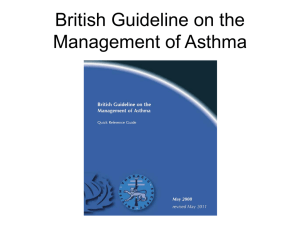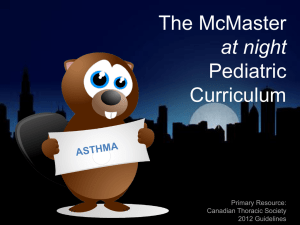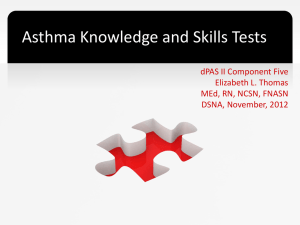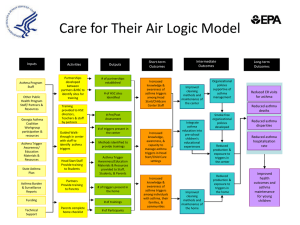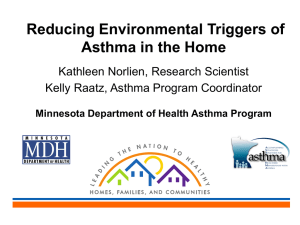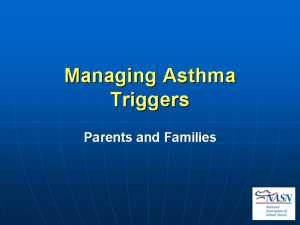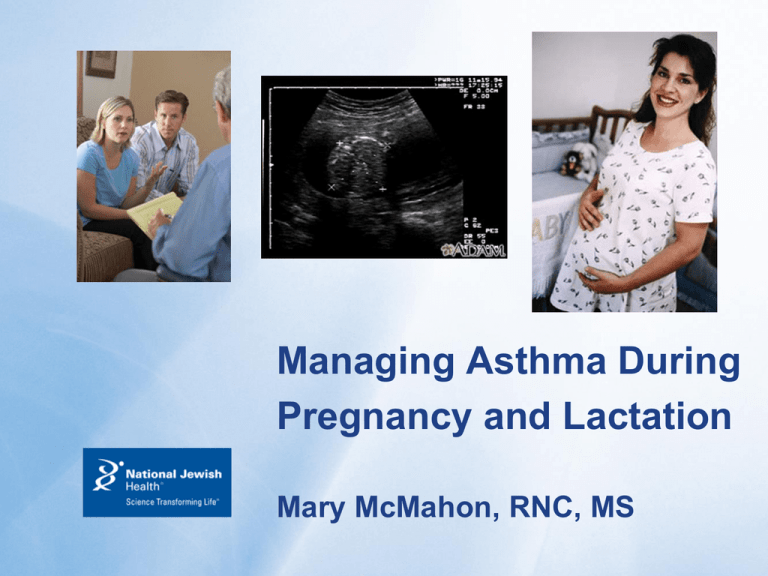
Managing Asthma During
Pregnancy and Lactation
Mary McMahon, RNC, MS
Guidelines for Asthma during Pregnancy
National Asthma Education and Prevention
Program (NAEPP)
• Working Group Report on Managing Asthma during
Pregnancy: Recommendations for Pharmacologic
Treatment – Update 2004
American College of Obstetrician and
Gynecologist (ACOG)
• Asthma in Pregnancy Bulletin 90, 2008, Reaffirmed
2012
Let’s Discuss…
• Asthma Control
• Management of Asthma during
Pregnancy and Lactation
• Educational Resources for Patients and
Professionals
Respiratory Physiology in Pregnancy
Respiratory Rate
Vital Capacity
Unchanged
Unchanged
Tidal Volume
Increased
Minute Ventilations
Increased
Minute Oxygen Uptake
Increased
Functional Residual Capacity
Decreased
Residual Volume of Air
Decreased
Airway Conductance
Increased
Total Pulmonary Resistance
Reduced
Changes in respiratory status occur more
rapidly in pregnant patients than in
nonpregnant patients
Effects of Pregnancy on Asthma
When women with asthma become
pregnant:
• One-third of the patients improve,
• One-third worsen,
• Last third remain unchanged
Effects of Asthma on Pregnancy
• One of the most common chronic
medical problem that occurs during
pregnancy
– Approximately 8% of pregnancy women
• Let’s take a deep look at this……..
Asthma is Characterized by
• Inflammation of the airways, with an
abnormal accumulation of eosinophils,
lymphocytes, mast cells, macrophages,
dendritic cells, and myofibroblasts.
• Leads to a reduction in airway diameter
caused by smooth muscle contraction,
vascular congestion, bronchial wall
edema and thick secretions.
Airway Inflammation
& Symptoms
Risk Factors
Inflammation
Airway
Hyperresonsiveness
Precipitating
Factors
Clinical
Symptoms
Adapted from NAEPP Expert Panel Report 2 & 3
Airway
Obstruction
Clinical Symptoms
•
•
•
•
Cough
Wheeze
Shortness of breath
Chest tightness
Asthma
• Impairment
– Frequency and intensity of symptoms
– Functional limitations
• Risk
– Likelihood of asthma exacerbations
– Progressive decline in lung functions
– Risk of adverse effects from treatment
Adapted from NAEPP, Expert Report 3
What Are Goals of Treatment?
• Your patient should be able to
– Participate in activities, including physical
activity without asthma symptoms
– Sleep through the night without asthma
symptoms
– Have normal or near normal lung function
– Minimal use of short-acting inhaled beta2agonist
– Have few, if any side effects from
medication taken
Goals of Therapy:
Asthma Control
• Reduce impairment
– Prevent chronic and troublesome symptoms (e.g.
coughing or breathlessness in the daytime, in the
night or after exertion)
– Require infrequent use (<2 days a week) of SABA
for quick relief of symptoms
– Maintain (near) normal pulmonary function
– Maintain normal activity levels (including exercise
and other physical activity and attendance at work
or school)
– Meet patients’ and families’ expectations of and
satisfaction with asthma care
NAEPP Expert Panel Report 3
Goals of Therapy:
Asthma Control
• Reduce risk
– Prevent recurrent exacerbations of asthma and
minimize the need for ED visits or
hospitalizations
– Prevent progressive loss of lung function; blood
oxygenation that ensures oxygen supply to fetus
– Provide optimal pharmacotherapy with minimal
or no adverse effects
NAEPP Expert Panel Report 3
Treatment Goal - Pregnant Asthma Patient
To provide optimal therapy to maintain
control of asthma for maternal health and
quality of live as well as for normal fetal
maturation.
When Asthma is not Controlled
Maternal health risks include:
• High Blood Pressure
• Preeclampsia, which can affect
– Placenta
– Kidneys
– Liver
– Brain
When Asthma is not Controlled
Risks to the Fetus include:
• Perinatal Mortality
• Intrauterine Growth Restriction
• Preterm Birth
• Low Birth Weight
Differential Diagnosis
Patients presenting with new respiratory
symptoms during pregnancy;
Is it......?
• Dyspnea
• GERD
• Chronic cough from postnasal drip
• Bronchitis
Goals
• What are the
patient’s and
family’s personal
goals?
Asthma Severity
• Severe persistent asthma 4
• Moderate persistent asthma 3
• Mild persistent asthma 2
• Intermittent asthma 1
Classification of Asthma Severity and
Control in Pregnant Patients
Components of Severity
Impairment
Risk
Intermittent
Mild
Persistent
Moderate
Persistent
Severe
Persistent
Symptoms
<2 days/wk or
less
>2 days/wk,
not daily
Daily
Throughout the
day
Nighttime
awakenings
<2 Xs/mth or
less
>2 Xs per
month
More than once a
week
Four times per
week or more
SABA prn
<2 days/wk
>2 days/wk,
not daily, not
>1 X/day
Daily
Several xs/day
Interference with
normal activity
None
Minor
limitation
Some limitation
Extremely limited
Lung function
Normal FEV1
between
exacerbations
FEV1>80%
FEV1/FVC
normal
FEV1>80%
FEV1/FVC
normal
FEV1>60%, but
<80%
FEV1/FVC reduced
5%
FEV1 <60%
FEV1/FVC reduced
>5%
Step 3
Step 4 or 5
Exacerbations
requiring oral
steroids
Recommended Step for
Initiating Treatment
0-1/yr
>2/yr
Step 1
Step 2
Asthma Severity
Dictates only initial therapy in the untreated patients.
• Intermittent asthma is appropriately treated with only shortacting beta-agonists for rescue and prevention of symptoms,
such as those that occur with exercise.
• Persistent asthma should be treated with inhaled corticosteroids
(ICS). If symptoms or rescue inhaler use are daily, nighttime
awakenings at least weekly, there is moderated interference
with normal activities, or there is reduced pulmonary function
when not having symptoms, then initial treatment should be
medium doses of ICS or a combination of low-dose ICS and a
long-acting inhaled beta-agonist.
Once the patient with asthma is receiving controller
medication, further adjustments to asthma therapy are
based on the level of asthma control.
Spirometry
• Get Valid
Spirometry Results
EVERY Time
• DHHS (NIOSH)
Publication No.
2011-135
Stepwise Approach to Asthma
Int.
Asthma
Step
1
Persistent Asthma
Step
2
Step
3
Step
4
Step
5
Step
6
Long Term Control Medication
Patient Education, Environmental Control, Comorbidities
Quick Relief Medication for all patients
Step
Up
Assess
Control
Step
Down
Level of Asthma Control
• Well-Controlled
• Not Well-Controlled
• Very poorly controlled
– Many patients experience poor control of
asthma
Adapted from NAEPP, Expert Report 3
Asthma Control Test
• Simple self assessment questionnaire
(takes few minutes)
• Patient fills out while waiting
• 70-75% accuracy in determining level of
asthma control
• Validated & Guidelines recommended
• Educates the goals of ‘Well Controlled’
Asthma Control Test
• 5 items completed by the patient
reflecting on the past 4 weeks
– Daytime and nighttime symptoms
– Activity limitations
– Rescue inhaler use
• Add up: 0 - 25
– > 20: well controlled
– 16 – 19: not well controlled
– < 15: very poorly controlled
• A 23 year old patient, G1P0 at 11 wks with history of
asthma was seen by her provider with recurrent
cough and wheeze. She admits to waking twice per
month with a cough and requiring albuterol twice per
week. The provider knows that according to the
EPR-3 guidelines, this woman’s level of asthma
control would be classified as:
A.
B.
C.
D.
Very well controlled
Well controlled
Not well controlled
Very poorly controlled
Controlling Asthma Triggers
• Smoking
• Avoiding Allergens
– Pollen
– Dust mites
– Pet dander
Team Approach to Managing Asthma
During Pregnancy
•
•
•
•
Expectant Mother and her family
Obstetrical Provider
Primary Care Provider
Asthma Specialist
– Refer to a specialist if asthma is poorly
controlled.
Asthma Action Plan
• Everyone with asthma should have an
asthma action plan.
– Developed with patient and provider
– Shows daily treatment
• What kind of medicines to take
• When to take medicines
– How to control asthma long term
– How to handle worsening asthma
– When to call the doctor or go to the ED
U.S. FDA Pregnancy Categories
Pregnancy Category
Definition
A
Well-controlled studies have failed to
demonstrate a risk to the fetus.
B
Animal reproduction studies demonstrate an
adverse effect on the fetus, There are no wellcontrolled studies in pregnant women. The
potential benefits of this drug may outweigh the
potential risks.
C
There is positive evidence of human fetal risk
based on adverse reaction data from research
or clinical experience. The potential benefits of
this drug may outweigh the potential risks.
D
Studies in humans and animals have
demonstrated fetal abnormalities. There is
positive evidence of human fetal risk. The risks
of this drug outweigh any benefit to its use.
How Medications Work?
• Bronchodilator
• Anti-Inflammatory
Stepwise Approach to Manage Asthma
Stepwise Approach to Asthma
• Asthma Medications
– Quick relief
• Taken when asthma symptoms
present
– Long term control
• Taken daily, even when asthma
well controlled
Stepwise Approach to Asthma
• Medications
– Preferred treatment
– Alternative treatment
– Consider variability in response
based on the individual
Stepwise Approach - 12 yrs-Adult (revised)
Int.
Asthma
Persistent Asthma
Step 6
Step 5
Step 1
SABA
prn
Step 2
Preferred
•ICS
(low dose)
Step 3
Preferred
ICS
(low dose)
Or ICS
(med dose)
&
•LABA
Step 4
Preferred
•ICS
(med dose)
&
•LABA
Preferred
•ICS
(high dose)
&
•LABA
+
•Omalizumab
•(if allergens)
Preferred
•ICS
(high dose)
+
•LABA
+
Oral
Corticosteroid
And
Consider
Omalizumab
(if allergens)
Long Term Control Medication
Patient Education, Environmental Control, Comorbidities
Quick Relief Medication for all patients (SABA)
Adapted from NAEPP, Expert Report 3
Step
Up
Assess
Control
Step
Down
Quick Relief Medication
• All levels of asthma severity require
short-acting beta2-agonist (SABA)
• Anyone with asthma can have a severe
exacerbation
Short-Acting Beta2-Agonists
• Used as a pretreatment before exercise
• Used to treat asthma symptoms
• Increased use >2 days per week
indicates inadequate asthma control
• Regular use not recommended
Long Term Control Medication
• Preferred treatment
• Inhaled Steroids
– Most effective long term control
medication for mild, moderate and
severe persistent asthma
Inhaled Steroids
•
•
•
•
•
•
•
Improve asthma control
Improve quality of life
Improve spirometry
Decrease airway hyper responsiveness
Prevent exacerbations
Reduce severity of symptoms
Reduce systemic steroids, ED visits,
hospitalizations and death
Inhaled Steroids
• Mometasone
– Twisthaler®
• Ciclesonide
– MDI
• Fluticasone
– MDI
• Budesonide
– Flexhaler ®, Respules®
• Beclomethasone
– MDI (HFA propellant)
Comparative Daily Dosage
Inhaled Corticosteroids
Medicine
Low Daily Dose
Med Daily Dose
High Daily Dose
Beclomethasone HFA 40
80 mcg per puff
2-6 puffs
1-3 puffs
More than 6-12 puffs
More than 3-6 puffs
More than 12 puffs
More than 6 puffs
Budesonide DPI
200 mcg/inhalation
1-3 puffs
More than 3-6 puffs
More than 6 puffs
Flunisolide 250 mcg per
inhalation
2-4 puffs
4-8 puffs
More than 8 puffs
Fluticasone HFA 44 mcg
110 mcg per puff,
220 mcg per puff
2-6 puffs
2 puffs
2-4 puffs
1-2 puffs
More than 4 puffs
More than 2 puffs
Fluticasone DPI 50 mcg
100 mcg per inhalation
250 mcg per inhalation
2-6 puffs
1-3 puffs
1 puff
3-5 puffs
2 puffs
More than 5 puffs
More than 2 puffs
Triamcinolone
75 mcg/inh
Mometasone DPI
200 mcg/inh
4-10 puffs
10-20 puffs
More than 20 puffs
1 puff
2 puffs
More than 2 puffs
Adapted from NAEPP Expert Panel Report 3 & ACOG Bulletin No. 90
Inhaled Steroids
• Increased effect in lungs with decreased
systemic side effects
• Side effects
– Thrush (oral candidiasis)
– Sore throat
– Hoarseness
– Dry mouth
Combination Therapy
• Preferred treatment
– Varies with age
• The combination of long-acting inhaled beta2agonists (LABA) added to low-to-medium
doses of inhaled steroids leads to
improvements in:
– Lung function
– Symptoms
– Reduced use of short-acting beta2-agonists
• Increase in inhaled steroid given equal weight
Anti-IGE Treatment
• Omalizumab
• Approved for:
– Poorly controlled moderate to severe
persistent asthma
– Year round allergies
– Individuals taking routine inhaled steroids
• Not recommended to initiate during
pregnancy
Oral Corticosteroids
• Action - Reduces and prevents
inflammation
• Pills
– Prednisone
– Methylprednisolone
• Short course to speed recovery with
moderate to severe exacerbation
Medication Technique Is Important
• Check inhalation technique at every visit
Medication Technique Is Important
• Patients should know
– How to use the device
– How to tell when the device is empty
– How to clean the device
• www.NJHealth.org
Maintaining Asthma Control
• Once asthma control achieved
– Gradual reduction of pharmacotherapy
(Step Down)
– Monitor asthma control with the goal of
providing optimal pharmacotherapy
with minimal or no adverse effects
Managing Exacerbations –
Home Treatment
• Assess Severity
• Initial Treatment
• Response
– Good
– Incomplete
– Poor
• Follow-up
Management of Exacerbations –
Emergency Dept. and Hospital Care
• Initial Assessment
• Initial Treatment depending on severity
– Mild to mod exacerbation
– Severe
– Impending or actual respiratory arrest
• Repeat Assessment
– Level of Response
Transition of Care
• Admit to Hospital Intensive Care
• Admit to Inpatient Unit
• Discharge Home
Key Patient Education Messages
Teach and reinforce at initial visit and
follow up
• Basic facts about asthma
• Well controlled asthma and patient's
current level of control
– Asthma Control Test
– Ask “How often are you using your SABA
in a week?”
Key Patient Education Messages cont
• Role of medications
• Patient skills
– Take medication correctly
– Environmental control measures
– Self monitoring
• Asthma Symptoms
• Use of peak flow
• Use of written asthma action plan
Patient Education Links
• Asthma, Allergies and Pregnancy Tip to Remember
American Academy of Allergy, Asthma & Immunology
(AAAI) (2013) Home>Conditions & Treatments>
Library>Asthma Library>http://www.aaai.org/conditionsand-treatments/library/asthma-library/asthma,allergies-andpregnancy/TTR
• Pregnancy is Complicated by Allergies and Asthma
American College of Allergy, Asthma & Immunology
(ACAAI), 2010. Retrieved 08/13/2013
http://www.acaai.org/allergist/liv_man/pregnancy.
• Asthma during Pregnancy March of Dimes, 2011. Retrieved
08/13/2013
http://www.marchofdimes.com/pregnancy/asthma-duringpregnancy.
Current Studies Related to Asthma
• Interaction between obesity and asthma
• Dietary fat intake, may be an important
modifier of airway inflammation
• Acetaminophen and folate may modify
asthma risk, although more data are needed
• The effects of vitamin D on asthma are (in
theory) significant, more date to come
• EXPECT Pregnancy Registry - XOLAIRR use
prior to conception or during pregnancy
Conclusions
• The ultimate goal of asthma therapy in
pregnancy is maintaining adequate
oxygenation of the fetus be preventing
hypoxic episodes in the mother.
• It is safer for pregnant women with
asthma to be treated with asthma
medications than it is for them to have
asthma symptoms and exacerbations.
References
•
•
•
•
•
American College of Obstetricians and Gynecologists (ACOG). (2008). Asthma
in pregnancy. ACOG Practice Bulletin No. 90. Obstet Gynecol 2008 111:457-64
American College of Obstetricians and Gynecologists (ACOG). (2008). ACOG
releases new recommendations on the management of asthma during
pregnancy. Retrieved from http://www.acog.org/about_acog/news_room/news_
releases/2008/acog_releases. Retrieved 06/18/2013.
Chambers, C., Asthma medications (2013) Clinician Reviews
http://www.clinicianreviews.com/index.php?id=31613&type=98&tx_ttnews[tt_ne
ws]=216. Retrieved 09/20/2013.
Enriquez, R., Griffin, M., Carroll, K., Wu, P., Cooper, W., Gebretsadik, T., …
Hartert, T. (2007). Effect of maternal asthma and asthma control on pregnancy
and perinatal outcomes. Journal of Allergy, Asthma & Immunology, 120(3), 625630.
Murphy, A., Proeschal, A., Brightling, C., Wardlaw, A., Parvord, I., Bradding, P.,
et al. (2012). The relationship between clinical outcomes and medication
adherence in difficult-to-control asthma. Thorax, 67, 751-753.
References cont
•
•
•
•
•
•
National Institutes of Health; National Heart, Lung, and Blood Institute [NHLBI].
(2002). Asthma are: quick reference diagnosing and managing asthma –
Revised 2012. Retrieved from http://nhlbi.nih.gov/guidelines/asthma/
National Institutes of Health; National Heart, Lung, and Blood Institute [NHLBI].
(2005). NAEPP working group report on managing asthma during pregnancy:
Recommendations form pharmacologic treatment-Update 2004. Retrieved from
http://nhlbi.nih.gov/health/prof/lung/asthma/ast.preg
National Institutes of Health; National Heart, Lung, and Blood Institute [NHLBI].
(2007). Expert Panel Report 3 (EPR-#): Guidelines for the diagnosis and
management of asthma. Retrieved from http://nhlbi.nih.gov/guidelines/asthma/
Rance, K. & O’Laughlen, M. (2013) Managing asthma during pregnancy.
Journal of the American Association of Nurse Practitioners, 25(2013), 513-521.
Schatz, M. & Dombrowskin, M., (2009). Asthma in pregnancy. NEJM
2009;360:1862-1869.
Weinberger, S. & Schatz, M., (2012) In B.S. Bockner, X.J. Lockwood & H.
Hollingswork (Eds), Management of asthma during pregnancy. UpToDate.
Retrieved from http://www.uptodateonline.com
Questions?
Comments?


